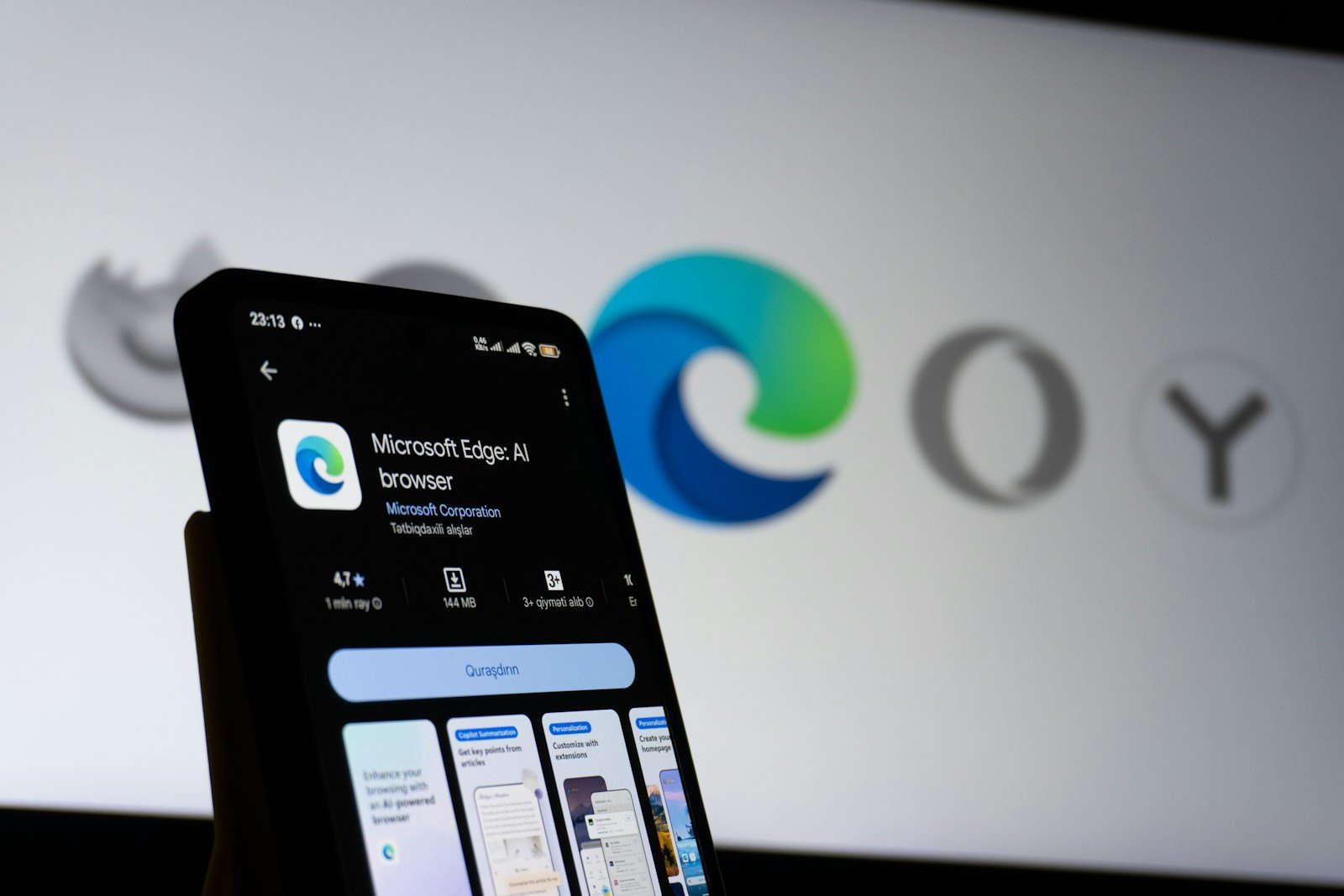Microsoft Edge has evolved significantly since its launch as the replacement for Internet Explorer. Microsoft Edge is an AI-powered browser designed to help users achieve more through unique features like Copilot, vertical tabs, and built-in VPN capabilities. As the default web browser for Windows and Xbox platforms, Edge continues to receive updates that expand its functionality beyond basic browsing.
In February 2023, Microsoft announced a major overhaul to Edge’s user interface, demonstrating their commitment to improving the browser experience. The company has also focused on making Edge more family-friendly with features like Kids Mode, which creates a safer space for children to discover the web. This balance of productivity tools and safety features shows Microsoft’s understanding of diverse user needs.
What Is Microsoft Edge?
Microsoft Edge is the official web browser developed by Microsoft, designed to be fast, secure, and integrated with Windows, macOS, iOS, and Android.
It replaced Internet Explorer as Microsoft’s primary browser and is built on the Chromium engine — the same open-source technology that powers Google Chrome.
(Sources: Microsoft Support, Digital Trends)
🧱 A Brief History
- 2015: Microsoft Edge launched alongside Windows 10, originally built on Microsoft’s own EdgeHTML engine.
- 2020: Microsoft rebuilt Edge using Chromium, improving compatibility, speed, and extension support.
- Today: Edge is available across all major platforms — including Windows, macOS, iOS, Android, and Linux — and is one of the top browsers worldwide.
(Source: GeeksforGeeks)
⚙️ Key Features of Microsoft Edge
1. Speed and Performance
Edge is optimized to use fewer system resources than Chrome, offering faster startup times and smoother browsing — especially on Windows devices.
2. Privacy and Security
Edge includes several built-in privacy tools:
- Tracking Prevention: Blocks trackers and ads that follow you across websites.
- Microsoft Defender SmartScreen: Protects against phishing and malware.
- Password Monitor: Alerts you if your saved passwords appear in data breaches.
(Source: Fingerprint)
3. Integration with Microsoft Services
Edge connects seamlessly with:
- Microsoft 365 for productivity tools (Word, Excel, Outlook).
- OneDrive for cloud storage.
- Cortana and Bing Chat for AI-powered assistance.
(Source: groundtap.com)
4. Collections
A feature that lets you save and organize links, images, and notes from the web — perfect for research or shopping lists.
5. Vertical Tabs and Workspaces
These tools help you manage multiple tabs efficiently and collaborate with others in shared browser sessions.
6. Immersive Reader Mode
Simplifies web pages by removing ads and distractions, making reading more comfortable.
7. Cross-Platform Sync
Edge syncs your bookmarks, passwords, and settings across all your devices when signed in with a Microsoft account.
🔒 Privacy & Security Overview
Edge offers three levels of tracking prevention:
- Basic: Allows most trackers for personalized ads.
- Balanced (default): Blocks harmful trackers while keeping websites functional.
- Strict: Blocks most trackers but may break some sites.
You can manage these settings under:
Settings → Privacy, search, and services
(Source: Microsoft Support)
🧩 Extensions and Customization
Because Edge is Chromium-based, it supports:
- Microsoft Edge Add-ons
- Google Chrome Web Store extensions
You can also:
- Change themes and appearance.
- Customize your new tab page.
- Use sidebar apps like Outlook, LinkedIn, and Copilot (Microsoft’s AI assistant).
📱 Edge Across Devices
| Platform | Features |
|---|---|
| Windows | Deep integration with Microsoft 365 and Windows security |
| macOS | Optimized for Apple hardware, same features as Windows |
| iOS & Android | Syncs tabs, passwords, and reading lists |
| Linux | Lightweight version for developers and open-source users |
⚖️ Edge vs. Chrome (2025 Comparison)
| Feature | Microsoft Edge | Google Chrome |
|---|---|---|
| Speed | Slightly faster on Windows | Fast but heavier on memory |
| Privacy | Built-in tracking prevention | Requires extensions |
| Integration | Microsoft 365, OneDrive | Google Workspace |
| Extensions | Supports Chrome Web Store | Native support |
| Battery Efficiency | More power-efficient on laptops | Higher energy use |
(Source: BrowserStack)
💡 Why Use Microsoft Edge?
You might prefer Edge if you:
- Use Windows or Microsoft 365 regularly.
- Want strong privacy without extra add-ons.
- Need a browser that’s fast, secure, and resource-efficient.
- Appreciate built-in tools like Collections, Immersive Reader, and Copilot AI.
🚀 How to Get Microsoft Edge
- Windows 10/11: Preinstalled by default.
- macOS, Linux, iOS, Android: Download from Microsoft Edge’s official site.
Once installed, you can import bookmarks, passwords, and settings from your previous browser easily.
✅ Summary
| Feature | Benefit |
|---|---|
| Chromium-based | Fast, modern, and compatible |
| Built-in security | Protects from phishing and malware |
| Microsoft integration | Seamless with 365, OneDrive, and Bing |
| Privacy controls | Customizable tracking prevention |
| Cross-device sync | Access data anywhere |
In short:
Microsoft Edge is a modern, secure, and efficient web browser that combines the speed of Chromium with Microsoft’s productivity ecosystem. It’s ideal for users who value privacy, performance, and deep integration with Windows and Microsoft services.
Key Takeaways
- Microsoft Edge offers AI-powered features like Copilot and vertical tabs that distinguish it from other Chromium-based browsers.
- Edge is continuously updated with new capabilities, including a major interface overhaul in 2023 and family safety features.
- The browser now serves as the default option across Microsoft platforms, replacing Internet Explorer while adding cross-platform compatibility.
Key Features and Enhancements
Microsoft Edge has evolved significantly with innovative features that set it apart from other browsers. The browser combines sleek design elements with powerful performance capabilities and robust security measures.
Design and User Experience Improvements
Microsoft Edge offers a clean, modern interface that’s easy to navigate. The browser includes vertical tabs, allowing users to view more tab titles at once without overcrowding the top of the window. This feature is especially helpful for those who work with multiple tabs simultaneously.
The Collections feature helps users organize web content efficiently. Users can gather images, text, and links from different websites into organized collections for research, shopping, or planning.
Edge includes a built-in screenshot tool that lets users capture, edit, and share web pages directly. The reading view removes distractions like ads and unnecessary images for a cleaner reading experience.
The customizable start page offers personalized news, weather updates, and quick links to favorite sites. Users can choose between different layout styles to match their preferences.
Performance Upgrades and Battery Efficiency
Edge uses the Chromium engine, which provides significant speed improvements over Internet Explorer. Pages load quickly, and the browser responds smoothly even with multiple tabs open.
The browser is designed to use fewer resources than competitors, helping computers run more efficiently. Tests show Edge uses less RAM than other major browsers, which is particularly beneficial for devices with limited memory.
Battery efficiency is a standout feature. Edge includes optimizations that can extend laptop battery life by reducing background activity and processor usage. This makes it an excellent choice for users who work on the go.
Sleeping tabs automatically free up resources by putting inactive tabs into a low-power state. This feature alone can reduce memory usage by up to 32% according to Microsoft’s data.
Security and Privacy Enhancements
Edge includes robust security features like SmartScreen protection that guards against phishing attempts and malicious software downloads. The browser automatically checks websites against a constantly updated database of known threats.
The built-in Password Monitor alerts users if their credentials appear in data breaches. This proactive approach helps users secure their accounts before potential unauthorized access.
Privacy settings are comprehensive and easy to manage. Edge offers three preset privacy levels:
- Basic (permits most trackers)
- Balanced (blocks potentially harmful trackers)
- Strict (blocks most trackers but may affect some websites)
Tracking prevention blocks third-party trackers from collecting user data across websites. Users can see how many trackers are blocked on each site they visit.
Edge also features a secure VPN option that encrypts internet connections to protect sensitive information, especially on public networks.
Cross-Platform Availability and Integration
Microsoft Edge offers seamless experiences across multiple devices and operating systems. The browser’s wide availability helps users maintain consistent browsing sessions regardless of the platform they’re using.
Windows 11 Optimization
Microsoft Edge is specially optimized for Windows 11, creating a deeply integrated browsing experience. The browser leverages the operating system’s native features for improved performance and battery efficiency.
Edge on Windows 11 supports enhanced security features like Windows Hello for password-free authentication. Users can enjoy smooth performance due to the browser’s efficient resource management.
The integration extends to the Start menu and taskbar, allowing quick access to Edge features. Snap layouts and other Windows 11 multitasking features work seamlessly with Edge, helping users organize their browsing alongside other applications.
Microsoft frequently updates Edge to take advantage of new Windows 11 capabilities as they become available.
Mobile Experience on iOS and Android
Microsoft Edge delivers a robust mobile experience on both iOS and Android platforms. The mobile versions maintain core features while adapting to touch interfaces and smaller screens.
Users can sync their browsing data, including favorites, passwords, and history across all devices. This creates a continuous experience when moving between desktop and mobile browsing sessions.
The mobile apps include reading mode, content blocking, and voice search capabilities. Edge’s Collections feature works on mobile devices, letting users organize web content into groups.
On Android, Edge integrates with the sharing system, making it easy to send links between apps. iOS users benefit from integration with Apple’s ecosystem while maintaining their Edge profile.
Address Bar and Search Data Features
Edge’s address bar combines search and navigation functions with intelligent suggestions. The browser analyzes browsing patterns to provide relevant recommendations when typing in the address bar.
Search data synchronizes across devices, allowing searches started on one device to be continued on another. Privacy settings let users control how much information is shared between installations.
The address bar offers quick access to features like calculator functions, weather updates, and unit conversions. Users can perform calculations directly in the address bar without opening another application.
Edge’s Bing integration enhances search capabilities with AI-powered answers and visual search options. The address bar supports custom search engines, giving users flexibility in how they search the web.
Frequently Asked Questions
Microsoft Edge continues to evolve with new features, privacy tools, and cross-platform capabilities. Users have many questions about the browser’s latest developments and how it compares to alternatives.
What are the recent updates and features added to Microsoft Edge?
Microsoft Edge has introduced several new features in recent months. Collections allows users to gather and organize web content for projects or research. This feature syncs across devices for seamless productivity.
Vertical tabs provide a better way to manage multiple open pages. Users can now view tab titles more clearly and organize their browsing more efficiently.
The browser now includes built-in screenshot and web capture tools. These allow users to capture, annotate, and share webpage content without additional software.
Performance improvements have also been implemented. Edge now uses less memory and CPU resources, resulting in faster page loading and smoother operation.
How does the latest Microsoft Edge enhance user privacy and security?
Microsoft Edge has strengthened its privacy features with enhanced tracking prevention. Users can choose between Basic, Balanced, and Strict settings to control how sites track their activity.
Password Monitor actively scans for compromised credentials. The browser alerts users if their saved passwords appear in data breaches, prompting immediate action.
SmartScreen protection helps identify and block phishing attempts and malware downloads. This feature evaluates websites and downloads against databases of known threats.
Edge now offers more transparent privacy controls. Users can easily view and manage site permissions, cookies, and browsing data through intuitive privacy dashboards.
Can Microsoft Edge be used on different operating systems, and how does the experience vary?
Microsoft Edge is available across Windows, macOS, iOS, Android, and Linux. The core functionality remains consistent across all platforms for a familiar experience.
Mobile versions of Edge offer features like content syncing and reading mode. Users can continue browsing sessions from desktop to mobile seamlessly.
The macOS version provides nearly identical features to Windows. Apple users experience the same performance benefits and security protections as Windows users.
Some platform-specific optimizations exist for better integration. Edge adapts to each operating system’s design language and unique capabilities where appropriate.
Are there any new integrations or partnerships associated with Microsoft Edge?
Microsoft Edge has deepened integration with Microsoft 365 applications. The browser now connects more smoothly with Teams, OneDrive, and other productivity tools.
Shopping features have expanded through retail partnerships. Edge can automatically find and apply coupons and compare prices when users shop online.
Educational institutions have new Edge tools through Microsoft Education partnerships. These include specialized learning features and administrative controls for classroom use.
Adobe and Microsoft have collaborated on PDF handling improvements. Edge now offers enhanced PDF reading, annotation, and form-filling capabilities.
How does the new Microsoft Edge compare to previous versions and other browsers?
The Chromium-based Edge delivers dramatically better compatibility than legacy Edge. Websites and extensions that work with Chrome now function properly in Edge.
Performance benchmarks show Edge often using less memory than Firefox and Chrome. This results in better speed on systems with limited resources.
Extension support has grown significantly with access to both Microsoft and Chrome stores. Users have access to thousands more extensions than with the original Edge.
The new design offers a cleaner, more modern interface compared to Internet Explorer. Navigation is more intuitive with streamlined controls and customization options.
What are Microsoft Edge’s plans for future development and innovation?
Microsoft has announced AI assistant features coming to Edge. These will help with writing, research, and content summarization directly in the browser.
Progressive Web App support continues to expand. Edge will improve the way web applications function like native apps on desktop and mobile devices.
Accessibility improvements are planned for upcoming releases. Microsoft aims to make Edge the most accessible browser for users with disabilities.
Gaming features are being developed specifically for the browser. These include optimizations for cloud gaming services and better performance for browser-based games.







